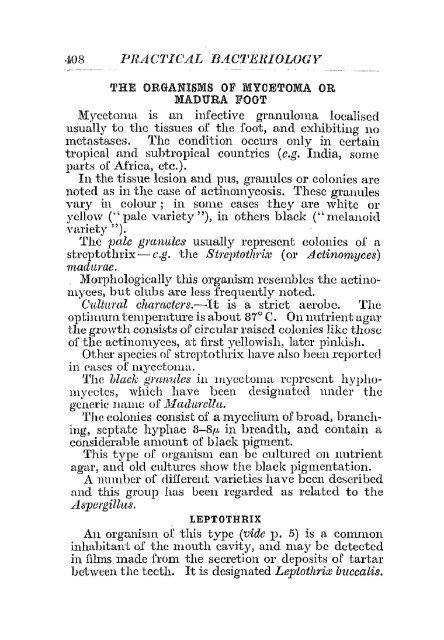AGf~ICULTURAL RESEARCH, PUSA.
AGf~ICULTURAL RESEARCH, PUSA.
AGf~ICULTURAL RESEARCH, PUSA.
Create successful ePaper yourself
Turn your PDF publications into a flip-book with our unique Google optimized e-Paper software.
408 PRACTICAL BAC'l'ERIOLOGl'<br />
THE ORGANISMS OF MYCETOMA OR<br />
MADURA FOOT<br />
Mycetorua is an infective granuloma localised<br />
usually to the tissues of the foot, and exhibiting no<br />
metastases. The condition occurs only in certain<br />
ti'opical and suhtropical countries (c.g. India, some<br />
parts of Africa, cte.).<br />
In the tissue lesion and pus, granules or colonies arc<br />
noteel as in the case of actinomycosis. These granules<br />
vary in colour; in some cases they are white or<br />
yellow C' pale variety"), in others black (" melanoid<br />
variety").<br />
The pale granulcs usually represent colonies of a<br />
streptothrix - c.g. the Strcptotlwix (or Actinomyces)<br />
rnadumc.<br />
Morphologically this organism rcsclnblcs the actinomyces,<br />
but clubs are less frequently noted.<br />
C11,lt'llTal chanwters.-It is a strict aerobe. The<br />
optimum temperature is about 37° C. On llutrient agtu'<br />
the gl'O"Ivth consists of' circular raised colonies like those<br />
of the actinomyce1>, at first yellowish, later pinkish.<br />
Other specics of strcptothrix have also been reported<br />
in cases of InycetolllH.<br />
The black /!,J'rtrmles ill mycc toma rcpresent hyphomyectes,<br />
which have been designated uuder the<br />
gcneric mune of 1l1adnTClla.<br />
The eolonies consist of a mycelium of broad, branching,<br />
septate hyphae 3-8{1. in breadth, and contain a<br />
considemble amount of black pigment.<br />
'This type of organism can be cultured on nutrient<br />
agar, and old cultures show the black pigmentation.<br />
A number of different varieties have bcen described<br />
and this group has been regarded as related to the<br />
Aspergillus,<br />
LEPTOTHRIX<br />
An organism of this type (vide p. 5) is a common<br />
inhabitant of the mouth cavity, and may be detected<br />
in films macle from the secretion or deposits of tartar<br />
between the teeth. It is designated Leptothrix buccalis.

















